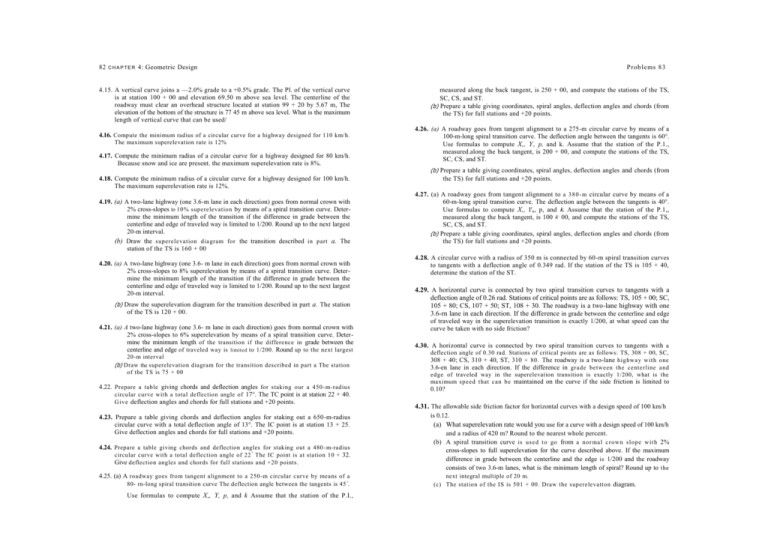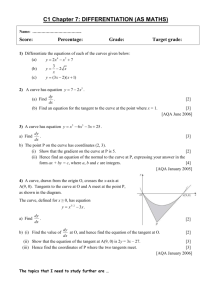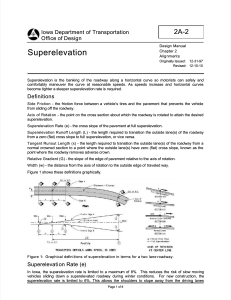82 CHAPTER 4: Geometric Design Problems 83 4.15. A vertical
advertisement

82 CHAPTER 4: Geometric Design 4.15. A vertical curve joins a —2.0% grade to a +0.5% grade. The Pl. of the vertical curve is at station 100 + 00 and elevation 69.50 m above sea level. The centerline of the roadway must clear an overhead structure located at station 99 + 20 by 5.67 m, The elevation of the bottom of the structure is 77 45 m above sea level. What is the maximum length of vertical curve that can be used/ 4.16. Compute the minimum radius of a circular curve for a highway designed for 110 km/h. The maximum superelevation rate is 12% 4.17. Compute the minimum radius of a circular curve for a highway designed for 80 km/h. Because snow and ice are present. the maximum superelevation rate is 8%. 4.18. Compute the minimum radius of a circular curve for a highway designed for 100 km/h. The maximum superelevation rate is 12%. 4.19. (a) A two-lane highway (one 3.6-m lane in each direction) goes from normal crown with 2% cross-slopes to 10% superelevation by means of a spiral transition curve. Determine the minimum length of the transition if the difference in grade between the centerline and edge of traveled way is limited to 1/200. Round up to the next largest 20-m interval. (b) Draw the superelevation dia gram for the transition described in part a. The station of the TS is 160 + 00 4.20. (a) A two-lane highway (one 3.6- m lane in each direction) goes from normal crown with 2% cross-slopes to 8% superelevation by means of a spiral transition curve. Determine the minimum length of the transition if the difference in grade between the centerline and edge of traveled way is limited to 1/200. Round up to the next largest 20-m interval. (b) Draw the superelevation diagram for the transition described in part a. The station of the TS is 120 + 00. 4.21. (a) A two-lane highway (one 3.6- m lane in each direction) goes from normal crown with 2% cross-slopes to 6% superelevation by means of a spiral transition curve. Determine the minimum length of the transition if the difference in grade between the centerline and edge of traveled way is limited to 1/200. Round up to the next largest 20-m interval (b) Draw the superelevation diagram for the transition described in part a The station of the TS is 75 + 00 4.22. Prepare a table giving chords and deflection angles for staking our a 450 -m-radius circular curve with a total deflection angle of 17°. The TC point is at station 22 + 40. G ive deflection angles and chords for full stations and +20 points. 4.23. Prepare a table giving chords and deflection angles for staking out a 650-m-radius circular curve with a total deflection angle of 13°. The IC point is at station 13 + 25. Give deflection angles and chords for full stations and +20 points. 4.24. Prepare a table giving chords and deflection angles for staking out a 480 -m-radius circular curve with a total deflection angle of 22 ° The IC point is at station 10 + 32. Give deflection angles and chords for full stations and +20 points. 4.25. (a) A roadway goes from tangent alignment to a 250 -m circular curve by means of a 80- rn-long spiral transition curve The deflection angle between the tangents is 45 °. Use formulas to compute X„ Y, p, and k Assume that the station of the P.I., Prob lems 83 measured along the back tangent, is 250 + 00, and compute the stations of the TS, SC, CS, and ST. (b) Prepare a table giving coordinates, spiral angles, deflection angles and chords (from the TS) for full stations and +20 points. 4.26. (a) A roadway goes from tangent alignment to a 275-m circular curve by means of a 100-m-long spiral transition curve. The deflection angle between the tangents is 60°. Use formulas to compute X,, Y , p, and k. Assume that the station of the P.1., measured.along the back tangent, is 200 + 00, and compute the stations of the TS, SC, CS, and ST. , (b) Prepare a table giving coordinates, spiral angles, deflection angles and chords (from the TS) for full stations and +20 points. 4.27. (a) A roadway goes from tangent alignment to a 3 8 0 - m circular curve by means of a 60-m-long spiral transition curve. The deflection angle between the tangents is 40°. Use formulas to compute X,, I's, p, and k. Assume that the station of the P.1,, measured along the back tangent, is 100 4- 00, and compute the stations of the TS, SC, CS, and ST. (b) Prepare a table giving coordinates, spiral angles, deflection angles and chords (from the TS) for full stations and +20 points. 4.28. A circular curve with a radius of 350 m is connected by 60-m spiral transition curves to tangents with a deflection angle of 0.349 rad. If the station of the TS is 105 + 40, determine the station of the ST. 4.29. A horizontal curve is connected by two spiral transition curves to tangents with a deflection angle of 0.26 rad. Stations of critical points are as follows: TS, 105 + 00; SC, 105 + 80; CS, 107 + 50; ST, 108 + 30. The roadway is a two-lane highway with one 3.6-rn lane in each direction. If the difference in grade between the centerline and edge of traveled way in the superelevation transition is exactly 1/200, at what speed can the curve be taken with no side friction? 4.30. A horizontal curve is connected by two spiral transition curves to tangents with a deflection angle of 0.30 rad. Stations of critical points are as follows: TS, 308 + 00, SC, 308 + 40; CS, 310 + 40, ST, 310 + 80. The roadway is a two-lane highwa y w it h one 3.6-en lane in each direction. If the difference in grade between the center line and edge of traveled way in the superelevation transition is exactly 1/200, what is the maximum speed t hat can be maintained on the curve if the side friction is limited to 0.10? 4.31. The allowable side friction factor for horizontal curves with a design speed of 100 km/h is 0.12. (a) What superelevation rate would you use for a curve with a design speed of 100 km/h and a radius of 420 m? Round to the nearest whole percent. (b) A spiral transition curve is use d t o go from a no r ma l c row n s lo pe w it h 2% cross-slopes to full superelevation for the curve described above. If the maximum difference in grade between the centerline and the edge is 1/200 and the roadway consists of two 3.6-m lanes, what is the minimum length of spiral? Round up to the next integral multiple of 20 m. (c) The station of the IS is 501 + 00. Draw the superelevatton diagram.






